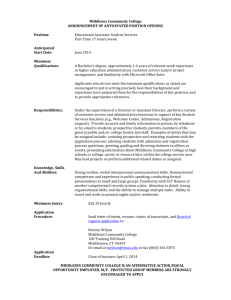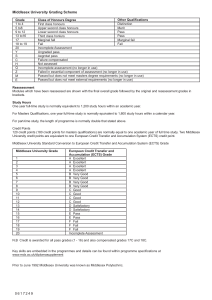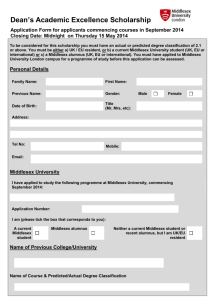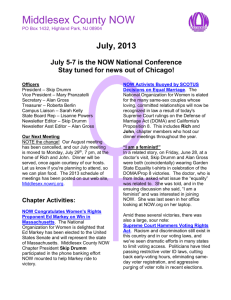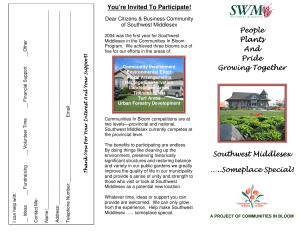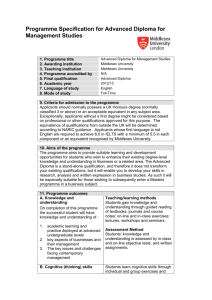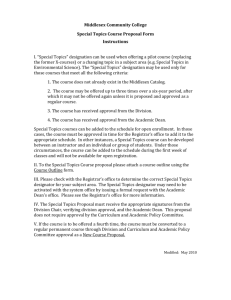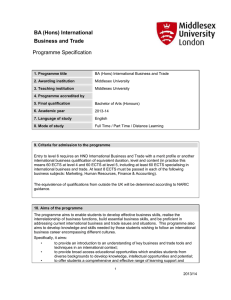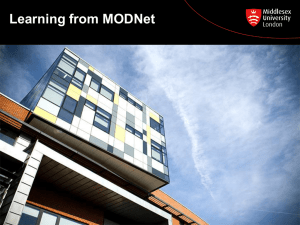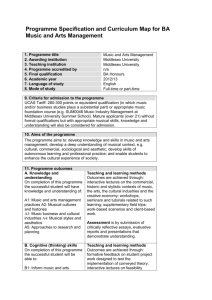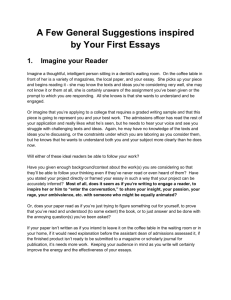Writing & the object – topics
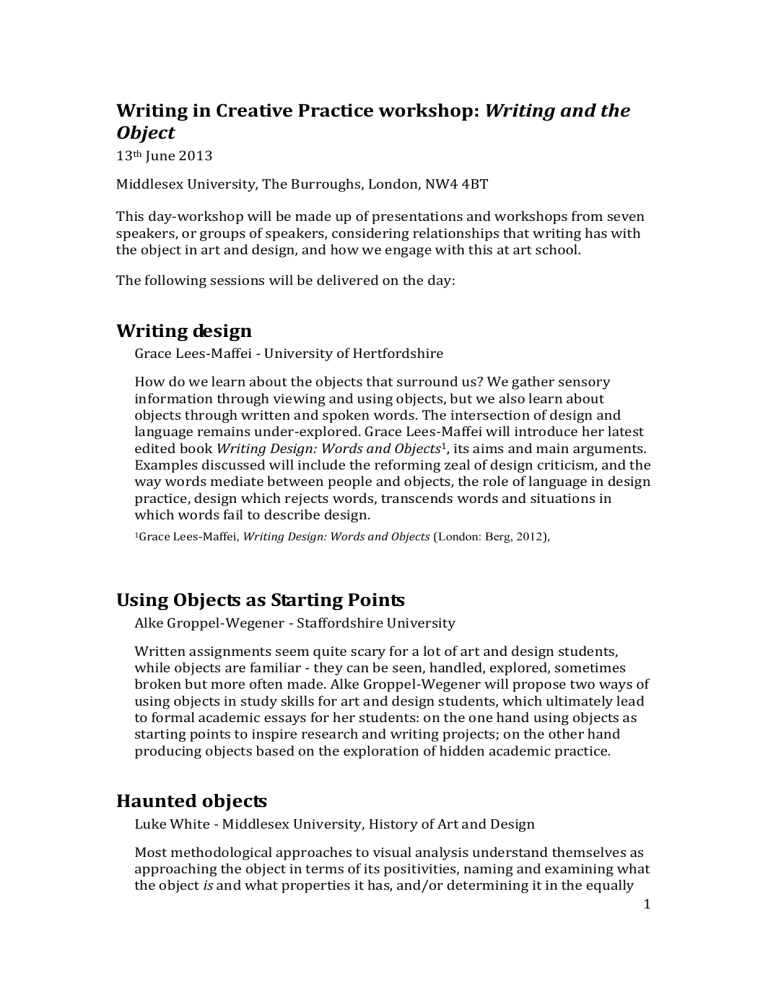
Writing in Creative Practice workshop: Writing and the
Object
13 th June 2013
Middlesex University, The Burroughs, London, NW4 4BT
This day-workshop will be made up of presentations and workshops from seven speakers, or groups of speakers, considering relationships that writing has with the object in art and design, and how we engage with this at art school.
The following sessions will be delivered on the day:
Writing design
Grace Lees-Maffei - University of Hertfordshire
How do we learn about the objects that surround us? We gather sensory information through viewing and using objects, but we also learn about objects through written and spoken words. The intersection of design and language remains under-explored. Grace Lees-Maffei will introduce her latest edited book Writing Design: Words and Objects 1 , its aims and main arguments.
Examples discussed will include the reforming zeal of design criticism, and the way words mediate between people and objects, the role of language in design practice, design which rejects words, transcends words and situations in which words fail to describe design.
1 Grace Lees-Maffei, Writing Design: Words and Objects ( London: Berg, 2012 ),
Using Objects as Starting Points
Alke Groppel-Wegener - Staffordshire University
Written assignments seem quite scary for a lot of art and design students, while objects are familiar - they can be seen, handled, explored, sometimes broken but more often made. Alke Groppel-Wegener will propose two ways of using objects in study skills for art and design students, which ultimately lead to formal academic essays for her students: on the one hand using objects as starting points to inspire research and writing projects; on the other hand producing objects based on the exploration of hidden academic practice.
Haunted objects
Luke White - Middlesex University, History of Art and Design
Most methodological approaches to visual analysis understand themselves as approaching the object in terms of its positivities, naming and examining what the object is and what properties it has, and/or determining it in the equally
1
positive terms of an authorial intent, a socio-historical origin, or its significance for a given user or viewer.
What, however, if we understand the object as (necessarily) "haunted", and what if we take these hauntings as the real concern of our engagements with art? Drawing on Jacques Derrida's Spectres of Marx 2 , and examining in particular an experience of Damien Hirst's Physical Impossibility of Death in
the Mind of Someone Living, I propose a shift from "ontological" to
"hauntological" approaches. My contention is that haunting is at the heart of our actual engagement with cultural objects and images, and that we therefore ought to be dealing with a complex phenomenology of spectrality and revenance when we discuss them.
Derrida's essay, written to consider the legacy of Marx's Communist Manifesto, also allows us to further ask whether this "hauntolgy" of the object is particularly apposite to the investigation of the phenomenology of a commodified, capitalist culture such as our own.
2 Jacques Derrida, Spectres of Marx: the state of the debt, the work of mourning and the new
international (London: Routledge, 2006)
The creative and the personal in writing on site
Tony Side, Anne Massey and Naomi House - Middlesex University, Interior
Design/Architecture
This presentation will consider the use of writing in analysing sites for architectural projects. In particular it will focus on the value of drawing on subjective perceptions, emotions and creative writing in responding to sites, and reflect on the role this approach can play in final year written portfolios by Interiors students.
Art, design and Dyslexia: multisensory routes to writing
Pauline Sumner Middlesex University, Dyslexia Support
Writing presents particular challenges for dyslexic art and design students.
Pauline Sumner will consider some of the myths and the realities of the relationship between dyslexia and art & design, and reflect on some of the multi-sensory approaches she and her colleagues use in addressing these challenges in bringing dyslexic art & design students to writing.
Writing before animation: generative writing as part of a design process
Peter Thomas - Middlesex University, Academic Writing and Language
Ossie Parker - Middlesex University, Animation
2
This session will reflect on the teaching of a generative writing cycle within an animation project. This kind of writing performs what Peter Medway calls a
‘shaping’ role in the design process 3 . We will show that although rare, explicit instruction on writing within studio practice like this has considerable potential, as it allows us to engage students in exploring often underexploited elements of their repertoire of studio practices.
3 Peter Medway ‘Virtual and Material Buildings: Construction and Constructivism in
Architecture and Writing’, Written Communication (13, 1996) p474
A Museum of Fashion: Writing about Fashion Through
Archive Collections
Emma Dick - Middlesex University, History of Art and Design
Richard Lumb - Middlesex University, Museum of Domestic Architecture
Marion Syratt Barnes - Middlesex University, Library
Peter Thomas - Middlesex University, Academic Writing and Language
‘Objects exist both internally and externally’ 4
This presentation considers the importance for novice design writers/researchers of engaging directly with objects they write about, and reflects on an approach to managing this engagement in considered stages.
The stages begin with personal (often undervalued) perceptions and move out towards integrating these with facts, contextual information and other people's ideas.
We will refer to work done by a multi-disciplinary teaching group with first year undergraduate students from the Fashion directorate, as part of their contextual studies module.
4 Jane Rendell, Site-Writing (London & New York: I. B. Tauris, 2010) p8
Please note:
This is a draft outline so amendments might be made to it closer to the event.
3
